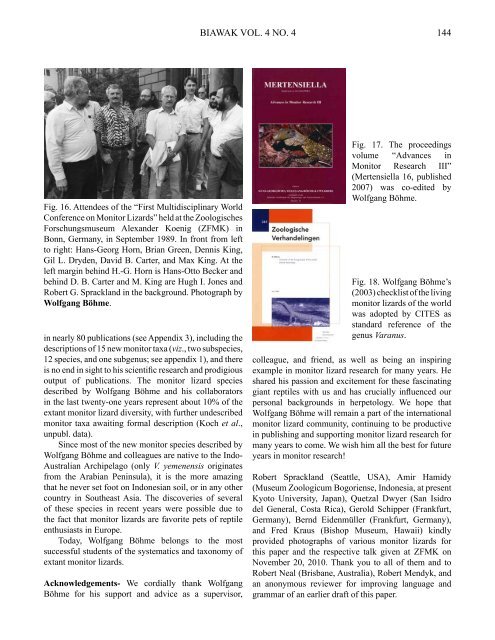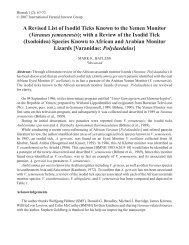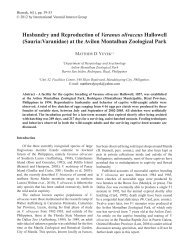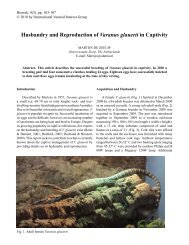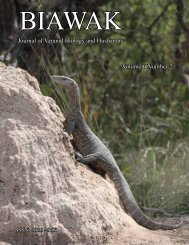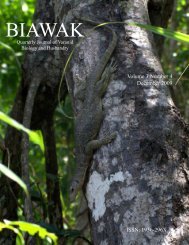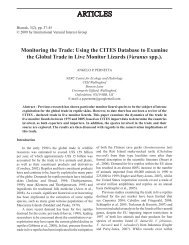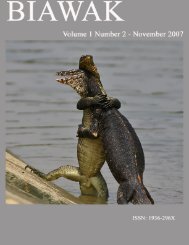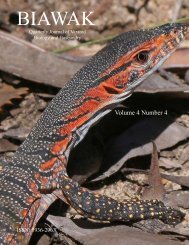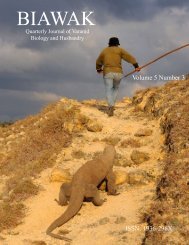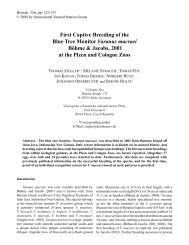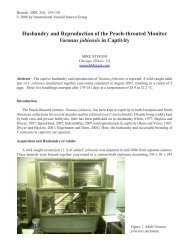BIAWAK - International Varanid Interest Group
BIAWAK - International Varanid Interest Group
BIAWAK - International Varanid Interest Group
- No tags were found...
Create successful ePaper yourself
Turn your PDF publications into a flip-book with our unique Google optimized e-Paper software.
<strong>BIAWAK</strong> VOL. 4 NO. 4<br />
144<br />
Fig. 16. Attendees of the “First Multidisciplinary World<br />
Conference on Monitor Lizards” held at the Zoologisches<br />
Forschungsmuseum Alexander Koenig (ZFMK) in<br />
Bonn, Germany, in September 1989. In front from left<br />
to right: Hans-Georg Horn, Brian Green, Dennis King,<br />
Gil L. Dryden, David B. Carter, and Max King. At the<br />
left margin behind H.-G. Horn is Hans-Otto Becker and<br />
behind D. B. Carter and M. King are Hugh I. Jones and<br />
Robert G. Sprackland in the background. Photograph by<br />
Wolfgang Böhme.<br />
in nearly 80 publications (see Appendix 3), including the<br />
descriptions of 15 new monitor taxa (viz., two subspecies,<br />
12 species, and one subgenus; see appendix 1), and there<br />
is no end in sight to his scientific research and prodigious<br />
output of publications. The monitor lizard species<br />
described by Wolfgang Böhme and his collaborators<br />
in the last twenty-one years represent about 10% of the<br />
extant monitor lizard diversity, with further undescribed<br />
monitor taxa awaiting formal description (Koch et al.,<br />
unpubl. data).<br />
Since most of the new monitor species described by<br />
Wolfgang Böhme and colleagues are native to the Indo-<br />
Australian Archipelago (only V. yemenensis originates<br />
from the Arabian Peninsula), it is the more amazing<br />
that he never set foot on Indonesian soil, or in any other<br />
country in Southeast Asia. The discoveries of several<br />
of these species in recent years were possible due to<br />
the fact that monitor lizards are favorite pets of reptile<br />
enthusiasts in Europe.<br />
Today, Wolfgang Böhme belongs to the most<br />
successful students of the systematics and taxonomy of<br />
extant monitor lizards.<br />
Acknowledgements- We cordially thank Wolfgang<br />
Böhme for his support and advice as a supervisor,<br />
Fig. 17. The proceedings<br />
volume “Advances in<br />
Monitor Research III”<br />
(Mertensiella 16, published<br />
2007) was co-edited by<br />
Wolfgang Böhme.<br />
Fig. 18. Wolfgang Böhme’s<br />
(2003) checklist of the living<br />
monitor lizards of the world<br />
was adopted by CITES as<br />
standard reference of the<br />
genus Varanus.<br />
colleague, and friend, as well as being an inspiring<br />
example in monitor lizard research for many years. He<br />
shared his passion and excitement for these fascinating<br />
giant reptiles with us and has crucially influenced our<br />
personal backgrounds in herpetology. We hope that<br />
Wolfgang Böhme will remain a part of the international<br />
monitor lizard community, continuing to be productive<br />
in publishing and supporting monitor lizard research for<br />
many years to come. We wish him all the best for future<br />
years in monitor research!<br />
Robert Sprackland (Seattle, USA), Amir Hamidy<br />
(Museum Zoologicum Bogoriense, Indonesia, at present<br />
Kyoto University, Japan), Quetzal Dwyer (San Isidro<br />
del General, Costa Rica), Gerold Schipper (Frankfurt,<br />
Germany), Bernd Eidenmüller (Frankfurt, Germany),<br />
and Fred Kraus (Bishop Museum, Hawaii) kindly<br />
provided photographs of various monitor lizards for<br />
this paper and the respective talk given at ZFMK on<br />
November 20, 2010. Thank you to all of them and to<br />
Robert Neal (Brisbane, Australia), Robert Mendyk, and<br />
an anonymous reviewer for improving language and<br />
grammar of an earlier draft of this paper.


